Pumpkin
Pumpkin (Cucurbitae pepo) It is also known as Kaddu or HalwaKaddu in hindi. It is a versatile and widely cultivated vegetable known for its nutritional value and culinary uses. Originating in from North America, Pumpkins are now grown globally, thriving in warm, temperate climates. India is the second largest producer of Pumpkin in World. This hardy crop belongs to the Cucurbitacae family and is characterized by its large, round, and often orange-hued fruits.
Pumpkins are valued for their flesh, seeds, and even their flowers, making them a staple in various cuisines and cultural traditions. It is a good source of Vitamin A and Potassium.
Season-
In north India, Pumpkin is grown in March-April and in South India, Pumpkins are grown in either in June-July or in January – February.
States-
Madhya Pradesh, West Bengal, Odisha, Uttar Pradesh, Chhattisgarh, Haryana are the leading producer of Pumpkin in India.
Optimum temperature required for its cultivation is around 20-27oC. Pumpkin is sensitive towards frost. For germination, soil temperature should be 15-21oC.
Pumpkins grow best in loamy soil that has excellent drainage and is enriched with organic matter. The ideal soil pH for cultivating pumpkins ranges from 6 to 7.
Spacing- Sow two seeds per hill and space them 60 cm apart. For hybrid varieties, plant seeds on each side of the bed with a spacing of 45 cm.
Sowing depth- Seeds are sown 1 inch deep in soil.
Method of Sowing- Direct Sowing
Seed Rate-
1kg of seeds are enough for cultivating in one acre.
Seed Treatment-
Treat seeds with Bavistin @2gm/kg of seeds to cure soil borne diseases.
Remove weeds and debris from the soil to reduce weed-crop competition for nutrients and prevent interference with planting. A well-prepared seedbed is crucial for pumpkin farming. Achieving this fine tilth often involves ploughing the soil with a local tractor to ensure optimal growing conditions. Incorporate well decomposed Farm Yard Manure to the soil before planting seeds.
Immediate watering should be given to seeds after sowing. Regular watering is important till germination of seeds. After germination, water should be applied once in 6-7 days.
Fertilizer requirement (kg/acre)
| Nitrogen | Phosphorus | Potassium |
| 40 | 20 | 20 |
Nutrient Requirement (kg/acre)
| Urea | SSP | MOP |
| 90 | 125 | 35 |
Before preparing the beds, incorporate 8-10 tonnes per acre of well-rotted farmyard manure (FYM). For fertilization, apply nitrogen at a rate of 40 kg per acre using 90 kg of urea per acre. Phosphorus should be supplied at 20 kg per acre using 125 kg of single superphosphate (SSP) per acre. Potassium is provided at 20 kg per acre using 35 kg of muriate of potash (MOP) per acre. Divide the nitrogen application into two parts: the first half is applied before sowing, and the remaining half is applied as a top dressing within one month.
To manage weed growth, it’s important to perform regular weeding or earthing up. Weeds can be controlled by using a hoe or manually removing them by hand. The first weeding should be carried out 2-3 weeks after sowing the seeds. Generally, 3-4 rounds of weeding are necessary to ensure the field remains free of weeds.
- Nitrogen-
Symptoms-
Pumpkin plants show yellowing of older leaves. They appear pale and slender, newer leaves retaining their green color. Plants also show stunted growth as the deficiency progresses.
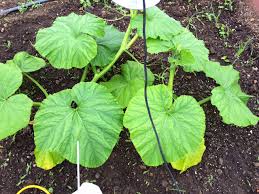
Management-
Foliar application of Urea @2% fortnightly.
- Potassium-
Symptoms-
Plants shows symptoms such as yellowing and browning of older leaves. Initially the symptoms appear on leaf margins and spread towards the veins. As the condition progresses, affected areas develop a brown scorched appearance, causing leaves to become dry and papery.
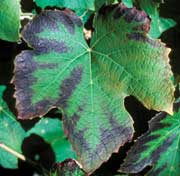
Management-
Foliar application of KCl @1% fortnightly .
- Calcium-
Symptoms-
Newly emerging leaves show scorching and distorting symptoms. Leaves curled downwards because their margins failed to expand completely. Mature and older leaves remain unaffected.
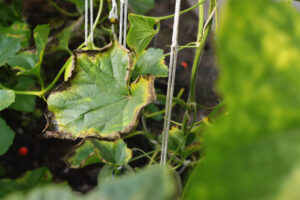
Management-
Gypsum can be applied in calcium lacking soils to overcome calcium deficiency. Calcium sulfate can be applied @2% solution in water.
- Magnesium-
Symptoms-
Symptoms like yellowing of older leaves can be seen in pumpkin plants. This symptom starts from the prominent veins of the leaves, leaving a thin border along the edges. As the deficiency progress, yellow leaves turn to tan in color.
Management-
Application of Magnesium Sulfate (MgSO4) @2kg per 100 L of water to overcome magnesium deficiency.
- Boron-
Symptoms-
Plant growth is retarded due to abnormal growth of fruits. Leaves exhibit yellow border along the margins. Corky patches develops around the fruit skin.
Management-
Apply Borax @2% at fortnightly interval.
- Iron-
Symptoms-
Iron deficiency in plants exhibit pale green chlorosis in new leaves plants while older leaves remain dark green in color. Initially, the veins of the affected leaves remain green and develop burnt like symptoms particularly when exposed to sunlight.
Management-
Foliar application of FeSO4 @0.5%
- Manganese-
Symptoms-
Symptoms such as mottled appearance can be seen on leaf blade which ranges from pale green to yellow.
Management-
Foliar application of MnSO4 @100gm/100 L of water.
- Air Pollution-
Symptoms-
- Leaf Discoloration
- Necrotic Patches
- Leaf Burn
- Stunted Growth
- Abnormal flowering and development
Curative Measures-
- Foliar spray of Calcium nitrate and magnesium sulfate.
- Use antioxidant solutions such as ascorbic acid or vitamin C or seaweed extracts. These can help mitigate stress caused by pollutants and enhance plant resilience.
- Apply Gypsum to the soil to enhance soil structure and mitigates the effects of pollutants like sulfur dioxide.
- Apply organic mulch around the base of plants to conserve soil moisture and reduce stress on the plants caused by pollutants.
- Rotate crops to minimize continuous exposure of Pumpkin plants to pollutants in the soil and air.
- Atrazine Pesticide Injury-
Symptoms-
Atrazine, a strong herbicide used extensively in grain farming, can leave behind residue that persist for years. This residual effect can limit the planting of broadleaf crops in the future. Crops show symptoms like stunted growth and severe leaf damage, resulting in diminished plant vitality and lower yields.

Management-
Avoid planting sensitive crops in field previously treated with persistent chemicals.
- Chilling/Frost Injury-
Chilling injury in plants occurs when plants are exposed to low temperature. This condition can leads to several symptoms and adverse effects in plants such as-
- Yellowing and water soaked appearance.
- Discoloration of fruits.
- Fruits may become soft, mushy and prone to disease.
- Leads to reduced growth and development.
- Abnormal ripening.
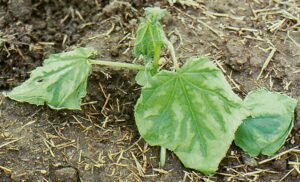
Management-
- Prune Plant affected areas.
- Ensure plants receive adequate water to alleviate stress. However, avoid watering, as waterlogged soils can exacerbate root damage.
- Apply balanced fertilizer.
- Apply mulch around plants to help regulate soil temperature and moisture levels, which can aid in reducing stress on recovering plants.
- Excess Soil Moisture-
Symptoms-
Excessive water can be as harmful as deficient water, particularly if flooding last more than 2-3 days. Roots need plenty of oxygen to thrive, but waterlogged soils quickly become deficient in oxygen. This can lead to stunted growth and nutritional deficiencies in plants due to poor root absorption. Water logged conditions increase the risk of root disease.
Management-
To promote proper drainage, level the fields and plants on raised beds. Avoid using fields with poor drainage capabilities.
- Salt Injury-
Symptoms-
High salinity from poor water quality or incorrect fertility practices can stunt plant growth and in severe conditions, leads to plant death. Plants exposed to elevated salt level often show initial dark green coloration, quickly developing at the edges and necrosis in older leaves.
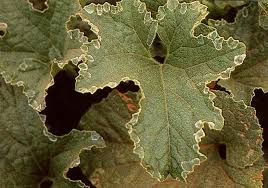
Management –
For crops grown in greenhouse and containers, it’s essential to carefully regulate the fertilization and watering practices. Ensuring that container plants are watered to the point of runoff will help avoid salt standup.
- Sulfur Injury-
Symptoms-
Symptoms such as marginal necrosis and stunted plant growth can be seen in plants.
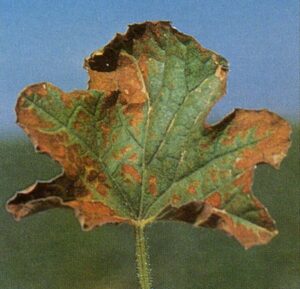
Management-
Apply sulfur containing compounds during moderate temperature of the day.
- Wind and Sand Injury-
Symptoms-
When Cucurbit Wind and Sand Injury occurs, plants show signs of wilting and become dry and brittle. The foliage may become shredded or ripped, and the fruit can develop small, pimple-like lesions where sand grains have damaged the epidermis.
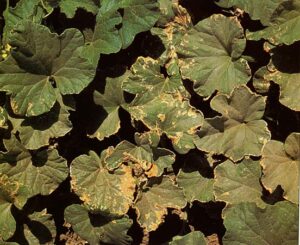
Management-
To minimize wind and sand injury, windbreaks can be planted at regular intervals.
- Squash Bug-
Stage of attack- Early growth Stages
Symptoms-
- Nymphs and adults feeds on leaves and release toxins in leaves.
- Squash bugs feeding causes yellowing of leaves that later changes into brown in color.
- Feeding also affects the flow of water and nutrient uptake, which results into wilting of plants.
- Young plants are more susceptible to damage as compare with older ones.


Management-
- Collect and remove the affected plants from the field and maintain field sanitation.
- Practice crop rotation.
- Apply Malathion 50%EC @250-300ml/acre.
- Aphids-
Stage of attack- Seedling, Vegetative and Flowering
Symptoms-
- Small pear shaped bodies insect can be seen on the leaves and stems of the plant.
- Aphids feeds on tender shoots and under surface of leaves by sucking the leaf cap causing curling and crinkling of the leaves.
- Black soot mold development due to honeydew secretion on the leaves.
- Leads to stunted growth and reduce the photosynthetic activity of the plant.
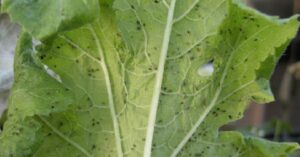
Management-
- Set up yellow sticky trap @4-6 acre
- Apply following insecticides-
Azadirachtin 5% SC @0.5ml/L of water
Profenofos 40% SC + Cypermethrin 4% EC @2ml/L of water
- Squash Vine Borer-
Stage of attack- Fruiting and flowering stage
Symptoms-
The initial sign of a borer infestation is the wilting of the affected plants. Near the entrance holes, the stem will have a mushy, soft texture. If plant left untreated then plant will die off.

Management-
- Use transplant instead of seedlings
- Collect and remove the affected plants from the field and maintain field sanitation.
- Practice crop rotation to minimize the risk of spreading of borers.
- Application of Carbaryl 4L @1ml/L of water.
- Pumpkin Beetles-
Stage of attack- Early Seedling Stage
Symptoms-
- Adult beetles and larvae consume the leaves of Pumpkin plants with great intensity, leaving behind irregular holes and a lace-like pattern due to their feeding.
- In heavy infestation, plants defoliate.
- Besides leaves, the beetles may also target tender stems, leading to damage and weakening the plant’s overall structure.
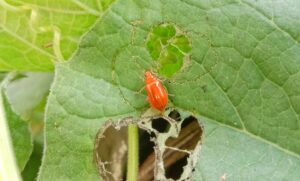
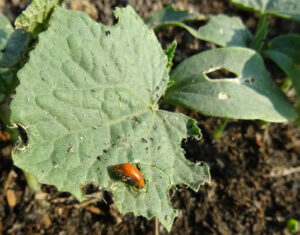
Management-
- Turning over the soil immediately after harvest interrupts the hibernation of adult pumpkin beetles, which can assist in controlling their population.
- Manually removing adult beetles can help lower their population and reduce damage to Pumpkin plants.
- Apply insecticides such as malathion 50 EC at a rate of 7 ml per liter of water, dimethoate 30 EC at 2.5 ml per liter, or methyl demeton 25 EC at 2 ml per liter.
- Blister Beetles-
Stage of attack- Fruiting Stage
Symptoms-
- Adult blister beetles feed on the leaves of pumpkin plants, creating irregular holes and consuming large portions of the foliage.
- Regular defoliation can weaken the plants and reduce the photosynthetic activity in plants.
- Affected plants show wilting symptoms, and dropping off plants.
- Plants also exhibit stunted or slowed growth result in severe damage of leaves and stems.
- Reduced growth can affect size and quality of seeds.
Management-
- Set up Pheromone trap @3-4/acre.
- Collect and destroy the affected plants from the field and maintain field sanitation.
- Control weeds
- Application of Deltamethrin @250ml/acre
- Pumpkin Fruit Fly-
Stage of attack- Young fruits
Symptoms-
- Secretion of resinous fluid from affected plants.
- Deformation and irregular formation of fruits
- Infected fruits are prone to premature dropping making them unsuitable for consumption.
Management-
- Collect and remove the infected plants from the field and maintain field sanitation.
- Apply Carbaryl 50%WP @3gm/L of water or Malathion 30 EC @1ml/L of water.
- Spotted Beetle-
Stage of attack- Seedling stage
Symptoms-
Spotted Beetles causes damage to Pumpkin by feeding on roots, flowers and foliage and transmit disease. Wilting symptoms can also be seen in severe infestation. Larvae causes severe damage to small plants as compare to large plants. Feeding may induce the risk of Fusarium wilt disease. Beetles also causes damage to fruits and reduce the market value. Grub and Adult scrap chlorophyll from the epidermal layers of the leaves.
Management-
- Manual Picking of Beetles.
- Remove and destroy all the affected plant parts from the field and maintain field sanitation.
- Foliar application of Malathion 50 EC @2ml/L of water
- Armyworms-
Stage of attack- Early Vegetative and Flowering
Symptoms-
- Armyworms eat the soft tissue between the veins, leaving a lace-like appearance.
- They also eat stems and veins causing wilting and reduced plant vigor.
- In severe infestation, armyworm feeds on fruits causing irregular holes leading to rot and secondary infections.
Management-
- Rotate crops to disrupt the life cycle of armyworms.
- Remove weeds and crop residue that can harbor larvae.
- Encourage beneficial insects such as parasitic wasp, lady beetle that feed on armyworm.
- Set up Pheromone trap @5-6/ acre.
- Apply Chlorantraniliprole @0.5ml/L of water.
- Cucumber Beetles-
Stage of attack- Seedling Stage
Symptoms-
Cucumber beetles larvae feeds on stems, and roots. They can kill seedlings while adults feed on leaves, petals, and flowers. Leads to defoliation in severe infestation. Also leads to stunted growth of the plants and reduce the overall yield of the plants.

Management-
- Rotate crops with grains, tomatoes or non-host crops.
- Plant resistant variety.
- Application of carbofuran 3% CG @5-7kg/acre
- Foliar application of Carbaryl @2.5gm/L of water
- Cutworm-
Stage of attack- Seedling stage
Symptoms-
- Cutworms feed on the stems of young watermelon plants, cutting them at or near the soil length, this cause plant to wilt or die.
- They also feed on leaves causing irregular holes or notches in the foliage.
Management-
- Apply Emamectin Benzoate 5%SG @0.5gm/L of water
- Flea Beetles-
Stage of attack- Seedling Stage
Symptoms-
- Adult beetles feeds on stems and leaves and causes severe damage there.
- Flea beetles inflict distinctive damage by creating shallow depressions and small, irregularly-shaped holes in the leaves.
- The larvae cause little or no damage to the plants.
- A slight yellowing may occur near the damaged tissue.
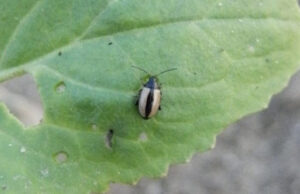
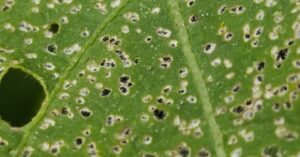
Management-
- Set up yellow sticky trap @4/acre
- Remove and destroy all the affected plant parts from the field and maintain field sanitation.
- Control weeds around the planting areas.
- Use Deltamethrin @250ml/acre.
- Thrips-
Stage of attack- Vegetative, flowering and Fruiting
Symptoms-
- Thrips feed on leaf surface and suck the plant juice causing small silvery, white or stippling spots on the leaves.
- Under severe infestation, leaves turn yellow, wither and become deformed.
- Growth is stunted.
Management-
- Set up yellow sticky trap @4-6/acre
- Application of Azadirachtin 1000 ppm @2ml/L of water
- Application of Thiamethoxam 25%WG @0.5gm/L of water
- Powdery Mildew-
Causal Organism- Erysiphe spp.
Symptoms-
- White powdery, spots or patches on leaves, stems and young growing parts of the plant. Later, it may grow spread rapidly and cover the entire surface.
- The white powdery spots may gradually turn yellow and become necrotic.
- The affected leaves may curl or become distorted.
- In severe infestation, plants may die prematurely.
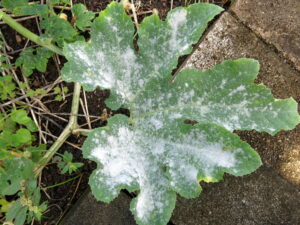
Favorable Conditions-
Warm Humid conditions, and temperature between 20-28oC favors the growth of this disease.
Management-
- Apply following fungicide-
Azoxytrobin 23%SC @1-1.5ml/L of water
Carbendazim 50%WP @0.5gm/L of water.
- Downy Mildew-
Causal Organism- Peronospora parasitica
Symptoms-
- Yellow to pale green spots forms on the upper surface and lower surface of the leaves, later these spots turn to brown in color.
- Entire leaves dries up quickly when disease progresses.
- Diseased plants get stunted and sometime may die off.

Favorable Conditions-
Mild temperature and wet weather favors the growth of this disease.
Management-
- Plant resistant varieties.
- Apply Mancozeb @2gm/L of water
- Gummy Stem Blight-
Causal Organism- Didymella bryoniae
Symptoms-
- Brown, black , water soaked lesions appear on stems which later become dry and wilt.
- Irregular tan to brown blotches appears on leaves which may lead to wilting and blight of the foliage.
- The development of reddish brown substance on the surface of lesions.
- Premature defoliation of the plants.

Favorable Conditions-
Temperature between 25-32oC, high relative humidity above 80% favors the growth of this fungus.
Management-
- Treat the seeds with Metalaxyl 35%WS @6-7gm/kg of seeds.
- Apply following fungicides-
Azoxytrobin 23%SC @1gm/L of water
Metalaxyl 8%+ Mancozeb 64%WS @1-1.5gm/L of water
- Angular Leaf Spot-
Causal Organism- Pseudomonas syringae
Symptoms-
- Brown spots can be seen with yellow halos
- Young spots appeared as water soaked lesions
- Older spots have holes in centre.

Favorable Conditions-
Warm- humid conditions, High relative humidity, Dense planting favors the growth of this disease.
Management-
- Use disease free clean seeds for propagation.
- Remove source of inolcum such as dead leaves and plants.
- Use drip irrigation instead of overhead irrigation.
- Remove and destroy affected plants from the field and maintain field sanitation.
- Application of Zineb 75%WP @600-800gm/acre.
- Anthracnose-
Causal Organism- Colleotrichum orbiculare
Symptoms-
- Small circular or irregularly shaped spots appear on leaves, stems and fruits that are dark brown and black in color.
- The spots may have water soaked appearance and may be surrounded by yellow halo.
- In severe infestation, leaves drop prematurely.
- Infected fruits may show sunken lesions, cracks and rot.
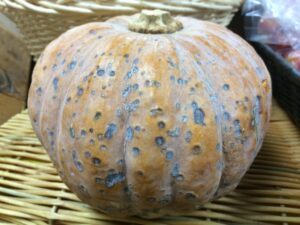
Favorable Conditions-
Warm, moist weather, favors the growth of this disease.
Management-
- Treat seeds with Carbendazim @2gm/kg of seeds before sowing.
- Spray Mancozeb @400gm/200 L of water.
- Cucumber Mosaic-
Causal Organism- Cucumber Green Mottle Mosaic Virus
Symptoms-
Curling, mottling, distorted leaves, stunted growth can be seen on the affected plants.

Favorable Conditions-
Relative Humidity of 90%, High soil moisture, frequent rain favors the growth of this disease.
Management-
- Destroy the affected plants from the field and maintain field sanitation.
- Keep the field weed free
- Remove alternated host from the field
- Use Insecticide to control the vector population which is aphids, therefore, only use insecticide which can control the aphids, Imidacloprid @0.5ml/L of water.
- Bacterial Leaf Spot-
Causal Organism- Xanthomonas cucurbitae
Symptoms-
- Small angular, brown or colored straw spots with yellow halos. Leaf spots dry out and drop off, leaving irregularly shaped holes in the leaves.
- Water soaked, tan small circular spots on fruits.
- Bacterial soft rot often develops after fruit spots and rot the entire fruit.
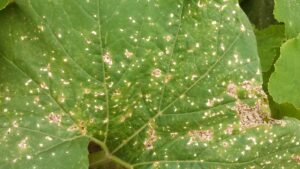
Favorable Conditions-
High relative humidity above 90%, Moist conditions, dense planting and warm temperature of 20-30oC favors the growth of this disease.
Management-
- Plant resistant varieties
- Use drip irrigation instead of overhead irrigation
- Remove and destroy the affected plants from the field and maintain field sanitation.
- Apply Mancozeb 75%WP @2gm/L of water
- Black Rot-
Causal Organism- Xanthomonas campestris
Symptoms-
- Initially, spots appear as brownish, moisture-saturated areas, and they may expand significantly.
- Later, these spots become dark and wrinkled
- In the center, pale dark brown spots can be seen.
Favorable Conditions-
High moisture, high temperature, poor air flow favors the growth of this disease.
Management-
- Apply Mancozeb 75%WG @2-2.5gm/L of water or Thiram 75 WP @ 2gm/L of water to control this disease.
- Fruit Rot-
Causal Organism- Phytopthora spp.
Symptoms-
- The fruit’s skin displays soft, dark green spots that appear waterlogged.
- The fruit’s interior turns soft and waterlogged, and the rotting matter gives off a bad odor.
Favorable Conditions-
Warm wet weather, temperature between 22-27oC favors the growth of this disease.
Management-
- Drench the soil with 0.25% Copper oxychloride.
- Fruits should be kept away from the soil.
- White Mold-
Causal Organism- Sclerotinia sclerotiorum
Symptoms-
- The first indication of infection in fruit and stems is a water-soaked appearance.
- On diseased areas, fluffy, white, cotton-like fungal growth is frequent.
- Small, hard sclerotia, black and raisin-like in appearance, eventually develop and are found embedded in the cottony mold.
- White mold commonly infects fruit at the blossom end. They became rotten and watery. Sclerotia may be present within the decaying fruit.
Favorable Conditions-
Warm temperature, high relative humidity favors the growth of this disease.
Management-
- Use wide row spacing , control weeds.
- Collect and remove all the infected plants from the field and maintain field sanitation.
- Do not compost infected fruits or other plant material.
- Practice crop rotation.
- Use fungicide that includes Chlorothalonil.
- Use mulch to prevent soil moisture.
Harvesting-
Depending on the variety, typically Pumpkins are ready for harvest in 75-100 days after sowing. Harvesting typically occurs when the fruit’s skin turns pale brown and the inner flesh becomes golden yellow. Mature fruits, which have good storage capacity, are ideal for long-distance transportation. Immature fruits are also harvested for sale purposes.
Use a sharp knife or pruners to cut the pumpkin from the vine. Leave about 2 to 4 inches of stem attached to the pumpkin. This helps prevent rot and gives it a nice handle. Be gentle when handling pumpkins to avoid bruising or damaging the skin. Use both hands to lift and carry them.
Yield-
The average yield of pumpkin is about 50-60 quintal/acre.